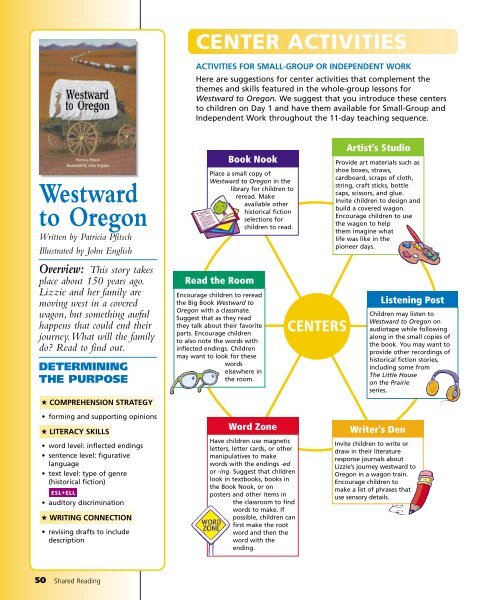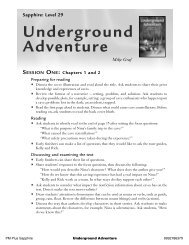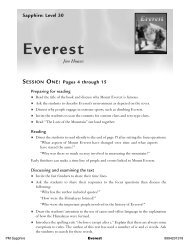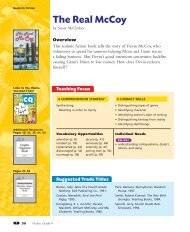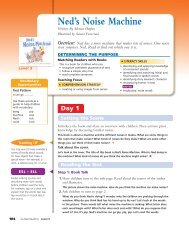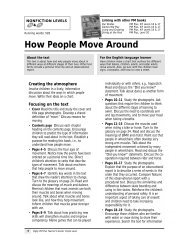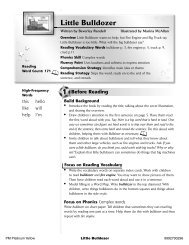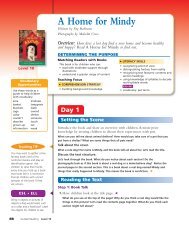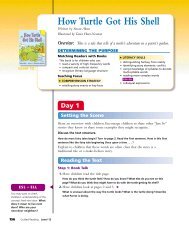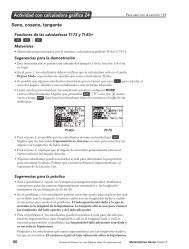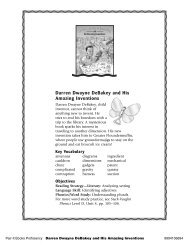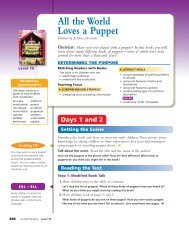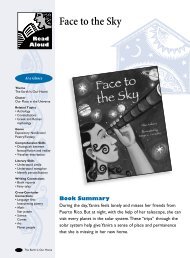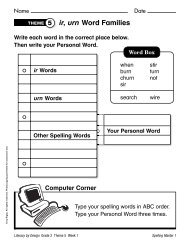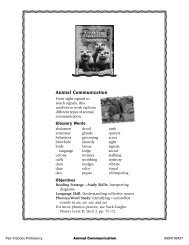Westward to Oregon - Rigby
Westward to Oregon - Rigby
Westward to Oregon - Rigby
You also want an ePaper? Increase the reach of your titles
YUMPU automatically turns print PDFs into web optimized ePapers that Google loves.
<strong>Westward</strong><br />
<strong>to</strong> <strong>Oregon</strong><br />
Written by Patricia Pfitsch<br />
Illustrated by John English<br />
Overview: This s<strong>to</strong>ry takes<br />
place about 150 years ago.<br />
Lizzie and her family are<br />
moving west in a covered<br />
wagon, but something awful<br />
happens that could end their<br />
journey.What will the family<br />
do? Read <strong>to</strong> find out.<br />
DETERMINING<br />
THE PURPOSE<br />
★ COMPREHENSION STRATEGY<br />
• forming and supporting opinions<br />
★ LITERACY SKILLS<br />
• word level: inflected endings<br />
• sentence level: figurative<br />
language<br />
• text level: type of genre<br />
(his<strong>to</strong>rical fiction)<br />
ESL•ELL<br />
• audi<strong>to</strong>ry discrimination<br />
★ WRITING CONNECTION<br />
• revising drafts <strong>to</strong> include<br />
description<br />
50 Shared Reading<br />
CENTER ACTIVITIES<br />
ACTIVITIES FOR SMALL-GROUP OR INDEPENDENT WORK<br />
Here are suggestions for center activities that complement the<br />
themes and skills featured in the whole-group lessons for<br />
<strong>Westward</strong> <strong>to</strong> <strong>Oregon</strong>. We suggest that you introduce these centers<br />
<strong>to</strong> children on Day 1 and have them available for Small-Group and<br />
Independent Work throughout the 11-day teaching sequence.<br />
Book Nook<br />
Place a small copy of<br />
<strong>Westward</strong> <strong>to</strong> <strong>Oregon</strong> in the<br />
library for children <strong>to</strong><br />
reread. Make<br />
available other<br />
his<strong>to</strong>rical fiction<br />
selections for<br />
children <strong>to</strong> read.<br />
Read the Room<br />
Encourage children <strong>to</strong> reread<br />
the Big Book <strong>Westward</strong> <strong>to</strong><br />
<strong>Oregon</strong> with a classmate.<br />
Suggest that as they read<br />
they talk about their favorite<br />
parts. Encourage children<br />
<strong>to</strong> also note the words with<br />
inflected endings. Children<br />
may want <strong>to</strong> look for these<br />
words<br />
elsewhere in<br />
the room.<br />
Word Zone<br />
Have children use magnetic<br />
letters, letter cards, or other<br />
manipulatives <strong>to</strong> make<br />
words with the endings -ed<br />
or -ing. Suggest that children<br />
look in textbooks, books in<br />
the Book Nook, or on<br />
posters and other items in<br />
the classroom <strong>to</strong> find<br />
words <strong>to</strong> make. If<br />
possible, children can<br />
first make the root<br />
word and then the<br />
word with the<br />
ending.<br />
CENTERS<br />
Artist’s Studio<br />
Provide art materials such as<br />
shoe boxes, straws,<br />
cardboard, scraps of cloth,<br />
string, craft sticks, bottle<br />
caps, scissors, and glue.<br />
Invite children <strong>to</strong> design and<br />
build a covered wagon.<br />
Encourage children <strong>to</strong> use<br />
the wagon <strong>to</strong> help<br />
them imagine what<br />
life was like in the<br />
pioneer days.<br />
Listening Post<br />
Children may listen <strong>to</strong><br />
<strong>Westward</strong> <strong>to</strong> <strong>Oregon</strong> on<br />
audiotape while following<br />
along in the small copies of<br />
the book. You may want <strong>to</strong><br />
provide other recordings of<br />
his<strong>to</strong>rical fiction s<strong>to</strong>ries,<br />
including some from<br />
The Little House<br />
on the Prairie<br />
series.<br />
Writer’s Den<br />
Invite children <strong>to</strong> write or<br />
draw in their literature<br />
response journals about<br />
Lizzie’s journey westward <strong>to</strong><br />
<strong>Oregon</strong> in a wagon train.<br />
Encourage children <strong>to</strong><br />
make a list of phrases that<br />
use sensory details.
Day 1 2 3 4 5 6 7 8 9 10 11<br />
WARMING UP<br />
Begin the lesson by rereading a familiar Big Book or poetry chart.You may wish <strong>to</strong><br />
ask a volunteer <strong>to</strong> pick a favorite.<br />
SETTING THE SCENE<br />
• Tap in<strong>to</strong> children’s prior knowledge.<br />
Have you ever moved or taken a long trip with your family? What was it like? How did<br />
you feel? What do you think a long trip in a covered wagon would be like?<br />
• Introduce the book and provide children with an overview.<br />
• Make predictions about the book. Invite children <strong>to</strong> look at the cover.<br />
Tell me about what you see on the cover. Have you ever seen wagons like these? When<br />
did you see them? What might Lizzie’s family see on their journey?<br />
READING THE TEXT<br />
1. Read the title page. Prompt children <strong>to</strong> predict what will happen in this book.<br />
Tell your neighbor what kind of trouble you think the people in a wagon train might<br />
encounter on a long journey like this.<br />
2. Use a pointer as you read the Big Book.You may also want <strong>to</strong> read the words of<br />
the different characters in different voices. Allow children ample time <strong>to</strong> view the<br />
illustrations without interrupting the flow of the s<strong>to</strong>ry.<br />
3. Before turning <strong>to</strong> page 12,ask:<br />
What do you think Mama will do if Papa is not back by morning? How do you think<br />
Lizzie feels? How can you tell how she feels? How would you feel?<br />
Allow children opportunities <strong>to</strong> express their opinions and experience the<br />
suspense of the s<strong>to</strong>ry as you read the rest of the book.<br />
RETURNING TO THE TEXT<br />
1. Discuss the s<strong>to</strong>ry. Use open-ended questions.<br />
Why do you think Mama treated Lizzie differently than Papa did? Why do you think<br />
Mama decided <strong>to</strong> stay behind when the wagon train left in the morning? Were you<br />
surprised? What would you have done?<br />
2. Reread sections of the book. Invite children <strong>to</strong> read some of the dialogues.<br />
Remember,the reading should be focused on enjoyment.<br />
SMALL-GROUP/INDEPENDENT WORK<br />
Introduce children <strong>to</strong> various center activities that will accompany your class study of<br />
this book. (You may wish <strong>to</strong> delay the introduction of the Word Zone until you have<br />
introduced inflected endings on Day 4.) Each child may then choose his or her own<br />
activity,or you may wish <strong>to</strong> assign activities <strong>to</strong> each group. Use this time <strong>to</strong> meet with<br />
guided reading groups.<br />
SHARING TIME<br />
Set aside a brief amount of sharing time,five <strong>to</strong> ten minutes,at the end of the session.<br />
Invite volunteers <strong>to</strong> share with the class what they learned while participating in<br />
Small-Group/Independent Work. Invite children <strong>to</strong> tell their classmates something<br />
they had difficulty with and what they did <strong>to</strong> problem solve. ✓<br />
✓<br />
Coaching Point<br />
Display a map of North America<br />
and invite volunteers <strong>to</strong> locate<br />
<strong>Oregon</strong> and where you are. Then<br />
explain that most wagon trains<br />
traveling the <strong>Oregon</strong> Trail started<br />
their journey in Missouri. Use the<br />
map’s scale <strong>to</strong> point out the<br />
distance between the two states.<br />
Coaching Point<br />
Children may have difficulty<br />
understanding who is speaking,<br />
because some of the quotations<br />
do not have dialogue tags. Point<br />
out that the author begins a<br />
new paragraph each time a<br />
different character speaks.<br />
✓Assessment<br />
These questions may be used on<br />
any day during sharing time <strong>to</strong><br />
gather information about<br />
children’s learning and interests<br />
during center time.<br />
• Describe the wagon you<br />
made in the Artist’s Studio.<br />
• Tell me about the books<br />
you read in the Book<br />
Nook. Were there any<br />
books similar <strong>to</strong> <strong>Westward</strong><br />
<strong>to</strong> <strong>Oregon</strong>?<br />
• Did you write in your<br />
journal? If so, what<br />
descriptive phrases with<br />
sensory details did you<br />
include?<br />
• Which words with -ed did<br />
you make in the Word<br />
Zone? With -ing? What are<br />
their root words?<br />
<strong>Westward</strong> <strong>to</strong> <strong>Oregon</strong> 51
✓<br />
✓Assessment<br />
Observe children as they read<br />
and form opinions on Day 2.<br />
Think about and note, mentally<br />
or in writing, the following:<br />
• Are children able <strong>to</strong> give<br />
examples from the book <strong>to</strong><br />
support their opinions?<br />
• Can children identify the ways<br />
in which characters are<br />
different?<br />
• Do children relate personal<br />
experience <strong>to</strong> support their<br />
opinions?<br />
52 Shared Reading<br />
WARMING<br />
UP<br />
Refer <strong>to</strong><br />
Day 1.<br />
WARMING<br />
UP<br />
Refer <strong>to</strong><br />
Day 1.<br />
Day 2<br />
WHOLE-GROUP INSTRUCTION<br />
Forming and supporting opinions<br />
1. Reread pages 2–7 of the Big Book<br />
<strong>Westward</strong> <strong>to</strong> <strong>Oregon</strong>. Introduce the<br />
comprehension strategy of forming and<br />
supporting opinions. As you read,model<br />
how the text and illustrations of the s<strong>to</strong>ry<br />
help you <strong>to</strong> form opinions about the<br />
characters and events. For example,after<br />
reading pages 4 and 5,you might say:<br />
Model As I was reading this part of the s<strong>to</strong>ry, I<br />
thought about how Mama and Papa treated<br />
Lizzie. The pictures on pages 2–7 and Papa’s<br />
words, "You’re as good at driving the team as I<br />
am," tell me that Papa lets Lizzie do things that<br />
girls don’t usually get <strong>to</strong> do. I think if I were<br />
Lizzie I would like that. I don’t think Mama feels<br />
the same as Papa though. What words or<br />
pictures in the book would support that opinion?<br />
2. Continue <strong>to</strong> read pages 8–15 with<br />
children. As you read,encourage children<br />
<strong>to</strong> tell their opinions about what is<br />
happening,as well as about how characters<br />
feel. During the discussion,invite children<br />
<strong>to</strong> relate relevant personal experiences <strong>to</strong><br />
support their opinions.<br />
3. Following the reading,list on chart paper<br />
children’s opinions and the part of the s<strong>to</strong>ry<br />
that they feel supports their opinion. ✓<br />
Day 3<br />
WHOLE-GROUP INSTRUCTION<br />
Forming and supporting opinions<br />
1. Read pages 16–24 of the Big Book<br />
<strong>Westward</strong> <strong>to</strong> <strong>Oregon</strong>. As you read,invite<br />
children <strong>to</strong> form opinions about the events<br />
and characters and <strong>to</strong> add these <strong>to</strong> the chart<br />
started on Day 2.<br />
Often when we read, we form opinions about<br />
the characters, and we decide whether we like<br />
each character or not. We form an opinion<br />
about each character by what the character<br />
says or does. As we read more, we may change<br />
our opinion. What additional information do<br />
we learn about the characters in this part of<br />
the book? How does this new information<br />
change your opinion of the characters?<br />
SMALL-GROUP/<br />
INDEPENDENT<br />
WORK<br />
Refer <strong>to</strong><br />
Day 1.<br />
SMALL-GROUP/<br />
INDEPENDENT<br />
WORK<br />
Refer <strong>to</strong><br />
Day 1.<br />
SHARING<br />
TIME<br />
Refer <strong>to</strong><br />
Day 1.<br />
SHARING<br />
TIME<br />
Refer <strong>to</strong><br />
Day 1.
WARMING<br />
UP<br />
Refer <strong>to</strong><br />
Day 1.<br />
WARMING<br />
UP<br />
Refer <strong>to</strong><br />
Day 1.<br />
Day 3<br />
continued<br />
WHOLE-GROUP INSTRUCTION<br />
Forming and supporting opinions<br />
2. Help children focus on the character of<br />
Mama by prompting them with questions.<br />
What did you think of Mama at the beginning<br />
of the s<strong>to</strong>ry? What words would you have<br />
used <strong>to</strong> describe her? What happened in the<br />
s<strong>to</strong>ry that made you feel this way? How did<br />
your opinion of Mama change as you read the<br />
s<strong>to</strong>ry? How did she show that she truly loved<br />
her family? Do you think her choice <strong>to</strong> stay<br />
behind showed she was brave or foolish?<br />
Why?<br />
3. Have children choose two characters from<br />
the s<strong>to</strong>ry and write a sentence or two<br />
stating their opinion of each character and<br />
why they feel this way.<br />
Day 4<br />
WHOLE-GROUP INSTRUCTION<br />
Inflected endings<br />
1. Use small self-stick notes <strong>to</strong> cover most of<br />
the inflected endings on pages 4 and 5 in<br />
the Big Book <strong>Westward</strong> <strong>to</strong> <strong>Oregon</strong>. Read<br />
aloud these pages.When you come <strong>to</strong> a<br />
word whose inflected ending is covered,say<br />
the root part of the word and have children<br />
say the ending. S<strong>to</strong>p periodically,and ask<br />
children how they knew which ending <strong>to</strong><br />
use. Lead children <strong>to</strong> understand that the<br />
ending -ed means the action happened in<br />
the past and that the ending -ing means the<br />
action continued for some time.<br />
2. Organize children in<strong>to</strong> small groups.<br />
Distribute <strong>to</strong> each group four index cards,<br />
two marked ed and two marked ing.<br />
Children can take turns selecting a card and<br />
saying a word with that ending. Children<br />
can identify the root word and then use the<br />
word with the ending in a sentence.<br />
✓<br />
• Rhyme Chart 10: Time in a Garden<br />
• Teaching Card 10B: Action Word Endings<br />
es, ing, s<br />
• Rhyme Chart 11: Joan’s Boat<br />
• Teaching Card 11B: Action Word<br />
Ending ed<br />
SMALL-GROUP/<br />
INDEPENDENT<br />
WORK<br />
Refer <strong>to</strong><br />
Day 1.<br />
SMALL-GROUP/<br />
INDEPENDENT<br />
WORK<br />
Introduce<br />
the Word<br />
Zone<br />
<strong>to</strong>day.<br />
Review<br />
the other<br />
center<br />
activities.<br />
SHARING<br />
TIME<br />
Refer <strong>to</strong><br />
Day 1.<br />
SHARING<br />
TIME<br />
Refer <strong>to</strong><br />
Day 1.<br />
✓<br />
ESL • ELL<br />
Be aware that some children<br />
may need extra practice<br />
distinguishing the spoken root<br />
words (for example, chuckle)<br />
from the spoken words with the<br />
-ed ending (chuckled).<br />
✓Assessment<br />
Observe children as they make<br />
words with inflected endings.<br />
Think about and note, mentally<br />
or in writing, the following:<br />
• Which children can correctly<br />
add endings <strong>to</strong> root words?<br />
• Which children can use words<br />
with the endings -ed and -ing<br />
in sentences?<br />
<strong>Westward</strong> <strong>to</strong> <strong>Oregon</strong> 53
Related Trade Book Titles<br />
The following trade books are<br />
excellent examples of his<strong>to</strong>rical<br />
fiction.<br />
When Jessie Came Across the<br />
Sea, Amy Hest, Candlewick<br />
Press, 1997.<br />
This Time Tempe Wick, Patricia<br />
Lee Gauch, Coward, McCann &<br />
Geoghegan, Inc., 1974.<br />
Coaching Point<br />
You may want <strong>to</strong> provide other<br />
types of fiction, including<br />
traditional tales or science<br />
fiction so that children can<br />
compare and contrast the<br />
different genres.<br />
54 Shared Reading<br />
WARMING<br />
UP<br />
Refer <strong>to</strong><br />
Day 1.<br />
WARMING<br />
UP<br />
Refer <strong>to</strong><br />
Day 1.<br />
Day 5<br />
WHOLE-GROUP INSTRUCTION<br />
Type of genre: his<strong>to</strong>rical fiction<br />
1. Tell children that <strong>Westward</strong> <strong>to</strong> <strong>Oregon</strong> is<br />
about made-up events,but it tells about a<br />
specific time period in his<strong>to</strong>ry. In addition,<br />
the s<strong>to</strong>ry details and the problems the<br />
characters face are ones that really occurred<br />
at that time in our country’s his<strong>to</strong>ry.This<br />
kind of book is called his<strong>to</strong>rical fiction.<br />
2. Write on the board the column headings<br />
Characters,Plot,Setting,and Time. Have<br />
children provide information for each of<br />
these categories.You may want <strong>to</strong> page<br />
through the Big Book <strong>Westward</strong> <strong>to</strong> <strong>Oregon</strong><br />
<strong>to</strong> spark ideas.<br />
3. Read each column aloud.<br />
Which of these things tell you that the s<strong>to</strong>ry<br />
happened during a specific time period?<br />
Explain your answer.<br />
Day 6<br />
WHOLE-GROUP INSTRUCTION<br />
Type of genre: his<strong>to</strong>rical fiction<br />
1. Encourage children <strong>to</strong> discuss how a s<strong>to</strong>ry<br />
like this teaches us about life in the past.<br />
Share with them some background<br />
information about the <strong>Oregon</strong> Trail.You<br />
might explain that the <strong>Oregon</strong> Trail was<br />
about 2,000 miles long and <strong>to</strong>ok about 6<br />
months <strong>to</strong> travel.There were no roads.The<br />
pioneers had <strong>to</strong> cross prairies,deserts,and<br />
mountains <strong>to</strong> get <strong>to</strong> <strong>Oregon</strong>.They had <strong>to</strong><br />
cross rivers without bridges.They needed <strong>to</strong><br />
travel close <strong>to</strong> rivers in order <strong>to</strong> have water.<br />
They usually did not have a doc<strong>to</strong>r<br />
traveling with them <strong>to</strong> care for the people<br />
who got sick or hurt.<br />
2. As you discuss what life was like for the<br />
people traveling the <strong>Oregon</strong> Trail,invite<br />
children <strong>to</strong> compare life back then with life<br />
<strong>to</strong>day. Draw a simple chart on the board or<br />
chart paper comparing such <strong>to</strong>pics as travel,<br />
food,communication,and emergency care.<br />
Invite children <strong>to</strong> list their ideas about each<br />
<strong>to</strong>pic for then and now.The completed chart<br />
might look something like the following:<br />
SMALL-GROUP/<br />
INDEPENDENT<br />
WORK<br />
Refer <strong>to</strong><br />
Day 1.<br />
SMALL-GROUP/<br />
INDEPENDENT<br />
WORK<br />
Refer <strong>to</strong><br />
Day 1.<br />
SHARING<br />
TIME<br />
Refer <strong>to</strong><br />
Day 1.<br />
SHARING<br />
TIME<br />
Refer <strong>to</strong><br />
Day 1.
WARMING<br />
UP<br />
Refer <strong>to</strong><br />
Day 1.<br />
WARMING<br />
UP<br />
Refer <strong>to</strong><br />
Day 1.<br />
Day 6<br />
WHOLE-GROUP INSTRUCTION<br />
Type of genre: his<strong>to</strong>rical fiction<br />
What Life Is Like Then Now<br />
Travel covered wagon, cars, trains, airplanes,<br />
horseback, no roads, highways, can travel<br />
<strong>to</strong>ok 6 months <strong>to</strong> travel same distance in a day<br />
from Missouri <strong>to</strong> <strong>Oregon</strong> on an airplane or a<br />
week in a car<br />
Food no s<strong>to</strong>res, had <strong>to</strong> bring hundreds of s<strong>to</strong>res and<br />
food for journey or restaurants, can s<strong>to</strong>p<br />
hunt for food, had <strong>to</strong> anywhere <strong>to</strong> buy food<br />
travel close <strong>to</strong> rivers for and water<br />
water<br />
Communication no phones, no mail people often travel<br />
with cell phones and<br />
can call for help<br />
Emergency care no doc<strong>to</strong>rs or hospitals, doc<strong>to</strong>rs and emergency<br />
people had <strong>to</strong> treat services available in<br />
themselves when sick nearly every <strong>to</strong>wn<br />
or injured<br />
3. After you have completed the comparison<br />
chart,encourage children <strong>to</strong> share their<br />
opinions about whether they would have<br />
liked <strong>to</strong> live back then. Have them support<br />
their opinions with details from the s<strong>to</strong>ry<br />
and the discussion.<br />
WHOLE-GROUP INSTRUCTION<br />
Figurative language<br />
Day 7<br />
1. Reread the second paragraph on page 3 of<br />
the Big Book <strong>Westward</strong> <strong>to</strong> <strong>Oregon</strong> and<br />
discuss how the author uses figurative<br />
language.<br />
Authors often use words that help us paint a<br />
picture in our mind. Sometimes authors also<br />
make interesting comparisons <strong>to</strong> help us<br />
visualize something. Close your eyes and I’ll<br />
read the sentence about the wagon train again.<br />
Tell me how it looks and sounds in your mind.<br />
What noises does the author compare <strong>to</strong> music?<br />
2. On chart paper write the sentence, The<br />
wagon was noisy. Ask children how this<br />
sentence is different from the author’s.<br />
What words or phrases could we use <strong>to</strong> help<br />
readers create a picture in their mind?<br />
Record several versions of the sentence and<br />
compare them. Save the chart for use on<br />
Days 9 and 10.<br />
continued<br />
SMALL-GROUP/<br />
INDEPENDENT<br />
WORK<br />
Refer <strong>to</strong><br />
Day 1.<br />
SMALL-GROUP/<br />
INDEPENDENT<br />
WORK<br />
Refer <strong>to</strong><br />
Day 1.<br />
SHARING<br />
TIME<br />
Refer <strong>to</strong><br />
Day 1.<br />
SHARING<br />
TIME<br />
Refer <strong>to</strong><br />
Day 1.<br />
Coaching Point<br />
Encourage children <strong>to</strong> think of<br />
all their senses as they<br />
participate in these language<br />
and writing activities. Use<br />
additional trade books <strong>to</strong><br />
provide children with other<br />
examples of figurative language<br />
and sensory details.<br />
Related Trade Book Titles<br />
The following trade books<br />
provide examples of figurative<br />
language.<br />
Nine for California, Sonia<br />
Levitin, Orchard Books, 1996.<br />
Dear Rebecca, Winter Is Here,<br />
Jean Craighead George,<br />
HarperCollins Publishers, 1993.<br />
The Island of the Skog, Steven<br />
Kellogg, Dial Books for Young<br />
Readers, 1973.<br />
<strong>Westward</strong> <strong>to</strong> <strong>Oregon</strong> 55
Coaching Point<br />
You may want <strong>to</strong> extend the<br />
activity by having children<br />
rewrite the following sentences<br />
<strong>to</strong> include describing words or<br />
comparisons:<br />
The dog caught the Frisbee.<br />
The girl walked home.<br />
He drove the bus.<br />
The noise was loud.<br />
She kicked the ball.<br />
Teaching s TIP<br />
Skip lines when you write so that<br />
you will have room <strong>to</strong> revise the<br />
work later. You may also want <strong>to</strong><br />
display examples of figurative<br />
writing from Days 7 and 8.<br />
56 Shared Reading<br />
WARMING<br />
UP<br />
Refer <strong>to</strong><br />
Day 1.<br />
WARMING<br />
UP<br />
Refer <strong>to</strong><br />
Day 1.<br />
WHOLE-GROUP INSTRUCTION<br />
Figurative language<br />
1. Discuss the comparisons (similes) in these<br />
sentences from the Big Book <strong>Westward</strong> <strong>to</strong><br />
<strong>Oregon</strong>: You’re going <strong>to</strong> grow up as wild as a<br />
coyote (page 5); Lizzie ate, but each bite felt like<br />
a bee buzzing in her s<strong>to</strong>mach (page 9); and She<br />
felt like she had swallowed a s<strong>to</strong>ne (page 17).<br />
2. Have children name objects,people,or events<br />
from the s<strong>to</strong>ry and record them on a sheet of<br />
chart paper—for example,a covered wagon,<br />
the wagon train,a whip,baby Jeremiah.<br />
Now let’s think of a comparison for one of<br />
these s<strong>to</strong>ry details. A wagon train, for<br />
instance, is long and thin like a rope or like a<br />
snake. Here are some comparisons we could<br />
make: The wagon train stretched across the<br />
land like a giant snake and The wagon train<br />
went on and on like a very long rope.<br />
3. Encourage children <strong>to</strong> think of<br />
comparisons for some or all of the s<strong>to</strong>ry<br />
details on the list. Record the comparisons<br />
and save them for use on Days 9 and 10. (It<br />
is not necessary <strong>to</strong> think of a comparison<br />
for each item on the list.)<br />
WHOLE-GROUP INSTRUCTION<br />
Revising drafts <strong>to</strong> include description<br />
1. Reread pages 18–24 of the Big Book<br />
<strong>Westward</strong> <strong>to</strong> <strong>Oregon</strong>.<br />
2. Have children brains<strong>to</strong>rm one or two<br />
possible continuations of the s<strong>to</strong>ry.<br />
What do you think happened next? How do you<br />
think Lizzie handled the horses? Do you think<br />
the family caught up with the wagon train?<br />
3. Tell children that <strong>to</strong>gether you will write a<br />
continuation for the s<strong>to</strong>ry. Encourage<br />
children <strong>to</strong> brains<strong>to</strong>rm a list of ideas. Explain<br />
that first you will decide which events <strong>to</strong><br />
write about.Then,with children’s help,put<br />
the events in an order that makes sense.<br />
Finally,with children’s assistance write a first<br />
draft. Save the work for use on Day 10.<br />
Day 8<br />
SMALL-GROUP/<br />
INDEPENDENT<br />
WORK<br />
Refer <strong>to</strong><br />
Day 1.<br />
Day 9<br />
SMALL-GROUP/<br />
INDEPENDENT<br />
WORK<br />
Refer <strong>to</strong><br />
Day 1.<br />
SHARING<br />
TIME<br />
Refer <strong>to</strong><br />
Day 1.<br />
SHARING<br />
TIME<br />
Refer <strong>to</strong><br />
Day 1.
WARMING<br />
UP<br />
Refer <strong>to</strong><br />
Day 1.<br />
Day 11<br />
WARMING<br />
UP<br />
Refer <strong>to</strong><br />
Day 1.<br />
WHOLE-GROUP INSTRUCTION<br />
Revising drafts <strong>to</strong> include description<br />
1. Reread with children what you wrote on<br />
Day 9.<br />
2. Encourage children <strong>to</strong> think of suggestions<br />
that might make the writing more<br />
descriptive. Refer <strong>to</strong> the lists of figurative<br />
language children made on Days 7 and 8<br />
for ideas. Add children’s suggestions. Suggest<br />
that children also look for correct<br />
capitalization,spelling,and punctuation.<br />
3. Read through the draft again,making sure<br />
that the changes are incorporated correctly<br />
and that they make sense. Explain that it is<br />
the writer’s decision which changes <strong>to</strong><br />
include in the final draft.Then,with<br />
children’s help,write a final draft of the<br />
s<strong>to</strong>ry’s continuation.<br />
• Mini-lesson 43: Adding details<br />
• Mini-lesson 45: Adding interesting words<br />
• Strategy Card: Writers learn from other<br />
writers.<br />
WHOLE-GROUP INSTRUCTION<br />
Celebration<br />
Reread the Big Book <strong>Westward</strong><br />
<strong>to</strong> <strong>Oregon</strong>, the s<strong>to</strong>ry<br />
continuation,and any other<br />
products generated during the<br />
previous 10 sessions. Invite<br />
children <strong>to</strong> share their<br />
thoughts and questions about<br />
the various activities they were<br />
involved in. Allow time for<br />
completion of activities. ✓<br />
SMALL-GROUP/<br />
INDEPENDENT<br />
WORK<br />
Refer <strong>to</strong><br />
Day 1.<br />
SMALL-GROUP/<br />
INDEPENDENT<br />
WORK<br />
Day 10<br />
SHARING<br />
TIME<br />
Refer <strong>to</strong><br />
Day 1.<br />
Review the various center activities<br />
that children may be involved in<br />
<strong>to</strong>day. On this final day,you may<br />
want <strong>to</strong> allow children <strong>to</strong> revisit a<br />
favorite center,<strong>to</strong> complete work at<br />
one of the centers,or <strong>to</strong> visit a center<br />
not yet visited while you meet with<br />
guided reading groups.<br />
✓<br />
✓Assessment<br />
• How independent and selfmotivated<br />
were children with<br />
their individual work?<br />
• To what extent were children<br />
able <strong>to</strong> correlate group lessons<br />
with their individual work?<br />
• Did children support their<br />
opinions with evidence found<br />
in text, illustrations, and<br />
personal experience?<br />
• How did children apply their<br />
knowledge and understanding<br />
of figurative language <strong>to</strong> their<br />
own writing?<br />
• Were children able <strong>to</strong><br />
compare and contrast various<br />
types of genre and articulate<br />
the characteristics of his<strong>to</strong>rical<br />
fiction?<br />
• What further instruction do I<br />
need <strong>to</strong> plan for the<br />
comprehension and literacy<br />
skills covered in this book?<br />
<strong>Westward</strong> <strong>to</strong> <strong>Oregon</strong> 57


